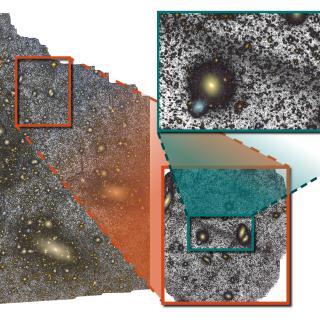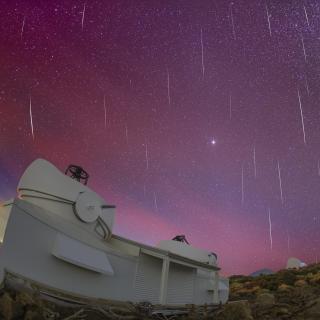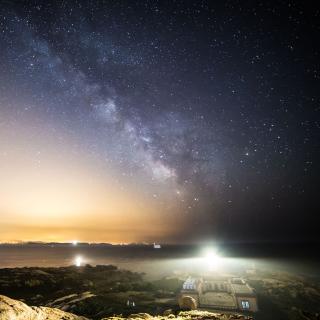The discovery will be published in July inAstrophysical Journal Letters
At thousands of light years above the plane of the Milky Way, the first black hole (XTE J1118+480) ever to be found in the Galactic halo has been detected by a team of Spanish, American and British astronomers using the 6.5 m Multiple Mirror Telescope (MMT) at Mount Hopkins Observatory in Arizona (USA), the 80 cm IAC-80 Telescope at Teide Observatory on Tenerife (Spain) and the 4.2 m William Herschel Telescope (WHT) at Roque de los Muchachos Observatory on La Palma (Spain). The coordinated observations of this object are the most detailed yet obtained and have enabled its mass to be determined with great precision. The discovery will be announced in the 20 July issue of Astrophysical Journal Letters.
During a two-month observing campaign at the end of last year, it became clear that the object had to be a black hole at least six times more massive than the Sun, comparable only with V404 Cygni, until now the best characterized black to date, discovered in 1992 friom Roque de los Muchachos Observatory by IAC astrophysicist Jorge Casares and coworkers. The new black hole is about 6000 light years away at an elevation of 62 degrees above the plane of the Milky Way. This in itself makes it an object of great interest since there is hardly any trace of the interstellar medium in the line of sight, which allows astronomers to study it at a level of detail that is impossible for other objects of a similar type. Its presence is betrayed by the movement of a normal star, smaller than the Sun, that orbits around it, slowly feeding mass into the black hole. The orbital period of the star is short, a mere 4.1 hours, which in astronomical terms means that this binary system is approaching the end of its active life.
'Until now,' says Casares (one of the discovery team), 'all the black hole studied have been confined, like the Sun, to the plane of our Galaxy. This new black hole, however, is ten times further from the plane than any other known black hole; this has important implications concerning its origin and evolution. It could be that this object was formed in the Galactic halo,
which would make it a member of a hitherto unknown population of black holes. But it is equally possible that this black hole formed in the Galactic plane and was later, for some reason, ejected to its present observed height. These are hypotheses that can be tested by undertaking a detailed study of the metallicity of the star orbiting the black hole. This we intend to do in the near future'
Spectra and lightcurves
The system was observed in the X-ray region of the spectrum a year ago by the Rossi X-ray Timing Explorer satellite (this is the type of radiation produced as gas from the normal star spirals in towards the black hole). The gas near a black hole is heated by friction and gravity, reaching a temperature of millions of degrees and radiating this thermal energy in the form of X-rays. Once, however, the X-ray emission switches off, the normal star becomes visible, thereby enabling the black hole's mass to be measured. Given the present faintness of the system (more than 160 000 times fainter than can be detected with the naked eye), it was necessary to use large telescopes such as the MMT in Arizona and the WHT of the Isaac Newton Group on La Palma to obtain a sufficient number of optical spectra during a complete orbit (4.1 hours) and thus be able to measure the movement of the star around the black hole.
Detailed lightcurves obtained with the IAC-80 Telescope at the Teide Observatory allowed the measurement of the geometrical distortion of the normal star in the intense gravitational field of the black hole. These observations, analysed with a computer code developed by Tariq Shahbaz, a researcher at the IAC, were critical for determining the the angle of inclination of the system (in other words, its orienatations with respect to the line of sight) and resulted in a precise calculation of the mass of the black hole - between 6 and 7.7 times the mass of the Sun.
The scientific team that have carried out this investigation comprises: Jorge Casares and Tariq Shahbaz, of the Instituto de Astrofísica de Canarias (IAC); Phil Charles, of the Physics and Astronomy Department of the University of Southampton (United Kingdom); Max Wagner, of the Large Binocular Telescope Observatory and Steward Observatory of the University of Arizona (USA); Craig B. Foltz, Director of the MMT of the University of Arizona/Smithsonian Institution (USA); and Sumner Starrfield, of the State University of Arizona (USA).
Link to webpage of the Physics and Astronomy Department of the University of Southampton:
http://www.astro.soton.ac.uk/


